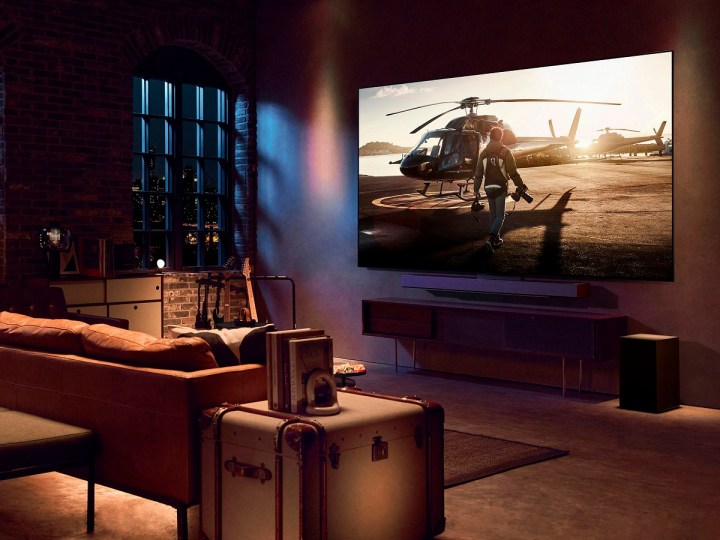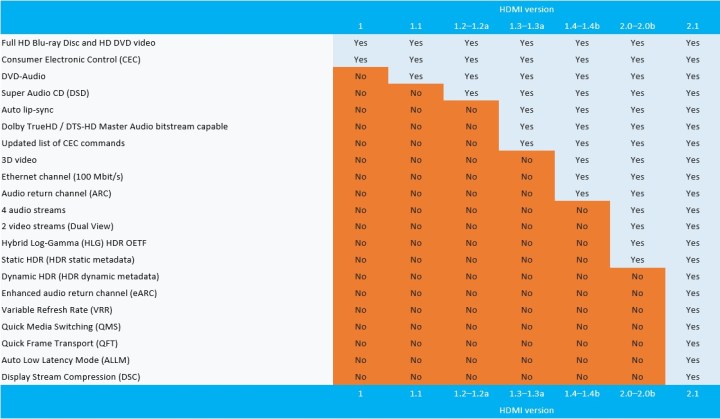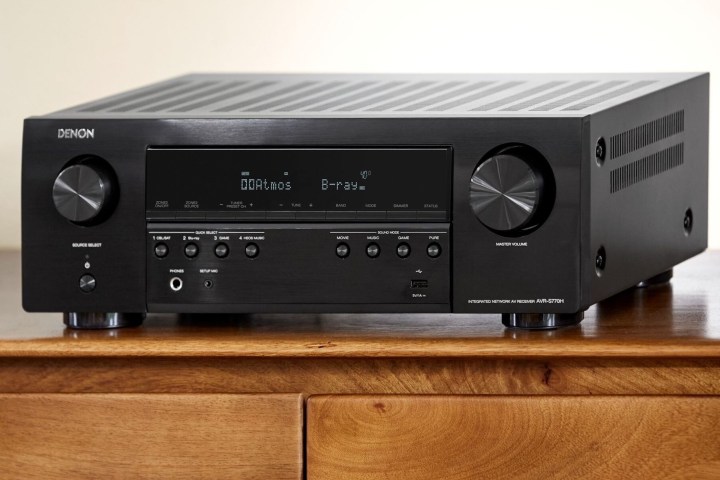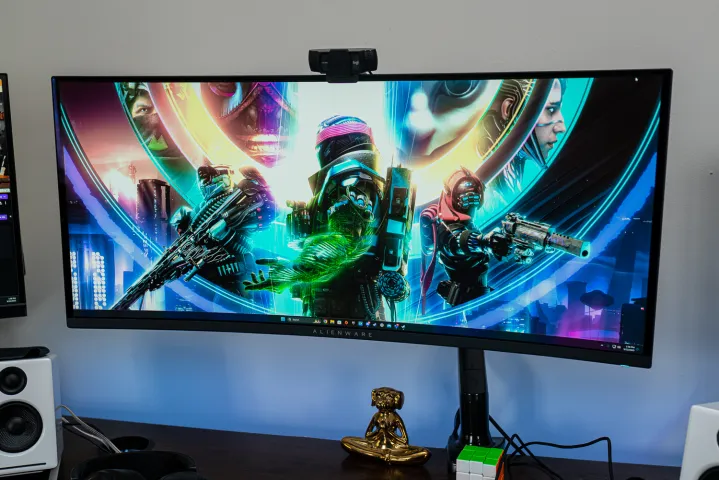HDMI technology arrived well over two decades ago and completely changed the way we set up and use our TVs, soundbars, home theater systems, and other AV components. Consolidating high-definition video and audio into one single wire, HDMI cables and ports helped to drastically cut down on wire clutter, while enhancing picture and sound quality across the board. But like most cutting-edge tech, HDMI has seen a number of improvements over the years. These evolutions in protocol and capabilities are referred to as “HDMI standards,” the oldest of which is HDMI 1.0.
- Is my new TV about to become obsolete?
- Is it okay to buy a TV that doesn’t have HDMI 2.1?
- Does HDMI 2.1 require new HDMI cables to work properly?
- Is HDMI 2.1 backward compatible?
- Can my HDMI 2.0b devices be firmware upgraded to HDMI 2.1?
- Why do we need a new HDMI version?
- What can HDMI 2.1 do that HDMI 2.0b can’t? What’s new?
- Do monitors have HDMI 2.1 too?
- Are there downsides to switching to HDMI 2.1?
At this time, the most common standard in use is HDMI 2.0b, but we’ve been seeing a lot of HDMI 2.1, as well. Believe it or not, HDMI 2.1 has already evolved to HDMI 2.1b! These advancements can be hard to keep up with, but each leap in standards brings a whole new set of features to the table. That being said, we’d like to give you a crash course in all things HDMI 2.1, so you’ll be better equipped to know what HDMI cables, TVs, and other home theater tech to be on the lookout for
Is my new TV about to become obsolete?
Absolutely not. If your TV supports 4K UHD resolution and high-dynamic-range (HDR) — or even just 4K — it is still a long way from obsolescence.
It’s true that HDMI 2.1 opens up a wealth of new possibilities, which we’ll get into shortly, but these features are rolling out slowly based on the state of consumer technology. The changes are exciting, but HDMI 2.1’s potential won’t be fully unlocked until technologies like 8K TV resolution and 4K at 120Hz go mainstream. But it’s getting there, especially when we look at the best TV for gaming currently on the market.
Bottom line: If you bought your TV within the past couple of years, you can breathe easily.
Is it okay to buy a TV that doesn’t have HDMI 2.1?

In the past, our advice was, “Go ahead and buy that TV with confidence.” HDMI 2.1 was still too far away. But if you’re intent on buying a flagship TV, we urge you to consider going with one that has HDMI 2.1 inputs. You’ll find a handful of great options from the likes of Samsung (the S95C), LG (the G3 OLED), TCL (the QM8 Series), and even Hisense (the U8K), all at fairly competitive prices.
But the other reason we urge you to go with an HDMI 2.1 set is that there have already been two modifications to the 2.1 standard. With HDMI 2.1a in the can, we’re already onto HDMI 2.1b, an evolution of the 48Gbps calling card that brings higher resolution support (8K/60Hz and 4K/120Hz), along with resolutions up to 10K for TVs that are much further down the line. The latest standard also brings a feature called Quick Media Switching (QMS, more on this below) to the table.
So, if you’re currently in the market, better to go with an HDMI 2.1-capable model that won’t break the bank and future-proof your home theater setup. On the other hand, if you’re more interested in saving money and looking for deals, don’t be afraid to pick HDMI 2.0 or something similar, as long as you understand what you’re giving up.
Does HDMI 2.1 require new HDMI cables to work properly?

Yes, with a capital “Y.” As you’ll learn in the spec rundown below, the new standard nearly triples the amount of data that can fit down an HDMI cable at once. To take full advantage of HDMI 2.1, you’ll need to use a new Ultra High-Speed Certified HDMI cable.
In some rare instances, it may be possible to use an existing Certified High-Speed HDMI cable with a newer HDMI 2.1 device, but since the amount of information being crammed down this digital pipeline is increasing at a rapid rate, we advise you to buy new Ultra High-Speed HDMI cables along with any HDMI 2.1-capable device that doesn’t already include them. If that sounds expensive, don’t worry — they don’t cost much more than standard High-Speed HDMI cables.
Wondering which HDMI cables you should buy? Check out our list of recommended HDMI cables for all kinds of devices and installations. Focus on the speed certifications of your cable, which helps ensure you’re getting a cable that is capable of supporting important HDMI 2.1 features.
It’s easiest to do this in person if possible: Look for the holographic. Ultra Certified Cable label attached directly to your HDMI cable, which includes a little QR code for authenticating. This stands for certification by the HDMI Licensing Administrator, so you know the cable can handle the speeds necessary to enable many important HDMI 2.1 features, such as high resolutions paired with higher refresh rates.
Is HDMI 2.1 backward compatible?
Yes. You will be able to connect any HDMI-enabled device supporting any older version of the HDMI standard, and it will work just fine on a new HDMI 2.1-enabled TV or display. Ultra High Speed HDMI cables are backward-compatible too. For instance, if in the future you want to connect your then-archaic Xbox One to your shiny new 8K TV with HDMI 2.1, that won’t be a problem at all. Nothing is changing about the size or connection type of the HDMI cable ports and jacks.
Can my HDMI 2.0b devices be firmware upgraded to HDMI 2.1?
In theory, yes. In practice, probably not. While there are premium chips out there that can be firmware upgraded, they are extremely expensive and rarely used by manufacturers. Chances are that your existing HDMI 2.0b devices don’t have one of those rare chipsets built into them.
Why do we need a new HDMI version?
Believe it or not, consumer-level home entertainment devices can already approach the 18Gbps bandwidth limits of HDMI 2.0b. Take a 4K Ultra HD Blu-ray disc, for instance: 4K image resolution on its own is a big bandwidth hog, but then add 10-bit color, 4:4:4 color sampling, 60 frames-per-second content, Dolby Atmos and DTS:X multichannel surround sound, HDR metadata, and all the other little bits that need to get from a 4K Ultra HD Blu-ray player or a streaming media player to a TV, and you get close to maxing out that 18Gbps limit.
How do you improve products if you’re already running out of space on the digital highway that carries all this video and audio information? You don’t. You have to pave a new, wider highway — and that’s exactly what the HDMI organization has done with HDMI 2.1.

Beyond the high resolution and increased frame rates Hollywood and game studios would like to use, more lines of communication needed to be opened up between devices sitting on either side of an HDMI cable. Right now, your Blu-ray player or game console can send tons of audio and video data to your TV, but it’s almost entirely a one-way conversation. By changing the way HDMI jacks and HDMI cables are structured, the HDMI organization was able to not only handle more traffic on the digital entertainment highway but also to route that traffic in a smarter way so that connected devices can maintain a proper, uninterrupted dialog.
In other words, if HDMI 2.0b is our existing, choked-up freeway system, then HDMI 2.1 is a mega-highway filled with self-driving cars, immune to bottlenecks, and instantly adapting to traffic fluctuations. So, what does that mean for you and your entertainment system?
What can HDMI 2.1 do that HDMI 2.0b can’t? What’s new?

Resolution is only the beginning. Let’s go through all the important feature upgrades.
Resolution
As we’ve established, HDMI 2.1 allows for higher resolutions at higher frame rates than before. With HDMI 2.0b, we could enjoy a maximum of 4K resolution at a maximum frame rate of 60Hz. With HDMI 2.1, we can get 4K at 120Hz, 8K at 60Hz, and up to 10K resolution for industrial and commercial applications.
This is particularly great news for gamers, as higher frame rates mean smoother, better-looking games. It’s also great news for the film industry, and the HDMI organization says some Hollywood directors are eager to migrate to 120Hz native filming as they look to deliver high frame rate content to the big screen and beyond.
eARC
The Audio Return Channel (ARC) is an HDMI 2.0b feature that lets audio move back and forth over an HDMI cable between a TV and an AV receiver or soundbar. Unfortunately, the limited bandwidth of HDMI 2.0b means that audio is often compressed and reduced down to stereo, resulting in “lossy,” lower-quality audio.
With HDMI 2.0’s Enhanced Audio Return Channel (eARC), we can now get uncompressed, full-resolution audio over HDMI 2.1 connections. Dolby Atmos is a perfect example. With ARC, Atmos only works when using Dolby Digital Plus, a compressed audio signal. eARC lets Dolby Atmos give its best performance using Dolby TrueHD, a “lossless,” high-resolution audio signal.
This will simplify system setups dramatically because it means users can connect everything to their TV and then run a single HDMI cable to their receiver or soundbar without losing sound quality. Fewer cables, less mess, better sound!
Dynamic HDR
The high-dynamic range is already the best improvement to TV picture quality since 1080p HD, but it can be even better. If you’re at all familiar with Dolby’s version of HDR, Dolby Vision, then you likely know the reason some reviewers consider it superior to other formats — it is a “dynamic HDR” medium. In other words, Dolby Vision makes changes to the settings of an image as the image itself changes. The result is a more accurate, vibrant, and … well … dynamic picture.
The only hangup with Dolby Vision is that it is a proprietary technology, and not every electronics manufacturer wants to pay licensing fees to use it. HDMI 2.1 brings dynamic HDR performance to other flavors, including the dynamic version of HDR10, known as HDR10+, and others, which should bring better HDR experiences to more TVs and more formats.
But wait: Isn’t HDR10+ already possible using HDMI 2.0b? Technically, yes, but it’s not an officially supported technology when done over HDMI 2.0b. HDMI 2.1 makes it official, which in turn should make it highly reliable.
Variable refresh rate
As we mentioned in the section on resolution, HDMI 2.1 can support higher frame rates for smoother video. But just as importantly from a gaming perspective, it allows for variable frame rates. Modern PC and console games do not use a single frame rate throughout the game. It varies — sometimes by quite a lot — depending on the complexity of the scene.
When frame rates drop or speed up, there is a mismatch between what the game is providing and what the TV is set to display. To compensate, the TV has to do some guesswork, and the result isn’t pretty. Lag, judder, and frame tearing are all symptoms of trying to play VRR games on an HDMI 2.0b non-VRR-capable display. HDMI 2.1 gives TVs the ability to be perfect big-screen gaming companions. That’s especially important if you are using new consoles like the Xbox Series X or PS5, which are built with VRR in mind.
Quick frame transport
This feature reduces the time it takes for a frame of video to pass from the source device (like a PC or console) to a display (like a TV or virtual reality — VR — headset). Again, this is great for gamers, who will notice much less lag, especially those who like fast-action, first-person shooters. VR users will benefit from an equally reduced time between movements and the world presented through their goggles.
Quick media switching
Utilizing the same HDMI VRR mechanism that hardcore gamers have been taking advantage of, Quick Media Switching (QMS) is a cool HDMI 2.1b feature that eliminates something called “blackouts.” This is that one- to three-second dropout in signal that occurs when you’re switching from one HDMI source to another. As long as Source B has the same resolution as Source A, HDMI 2.1b should allow you to change inputs without any blackout time whatsoever.
Auto low-latency mode (ALLM)
Yet another improvement for gamers, ALLM lets a TV or other display know when the signal is coming from a game console or PC. When that happens, the display can automatically turn off any picture processing that could introduce latency or lag. You’ll never have to select Game Mode on your TV again.
No more lip-sync issues
Currently, it can be a hassle to sync the video from your TV with the audio from your receiver or soundbar. This is because the TV may be using a heavy amount of processing, while the audio system’s processing takes far less time than the video processing.
The result is a delayed output of a video signal relative to an audio signal, and the result of that mismatch is sound that (oh-so-frustratingly) doesn’t match the timing of your picture. HDMI 2.1 will make it possible for TVs to talk in real time to AV receivers, soundbars, Blu-ray players, game consoles, and other source devices to ensure your video and audio are in perfect sync all the time.
Do monitors have HDMI 2.1 too?

Yes, they do — there are some excellent monitors with HDMI 2.1, especially for gaming. And brands like Asus have whole pages devoted to it. Keep in mind that you’ll need a GPU that also supports HDMI 2.1 features to really benefit. You don’t absolutely need HDMI 2.1 to reach 120Hz or even 144Hz refresh rates, but it is important for supporting both high refresh rates and high resolution at the same time.
Are there downsides to switching to HDMI 2.1?
If you were waiting for the catch in all of this coolness, there’s a potentially significant one. Unfortunately, that “HDMI 2.1” sticker on your TV’s box doesn’t guarantee that the display in question actually supports the HDMI 2.1 features that matter to you.
For instance, several of Sony’s 2021 HDMI 2.1 TVs shipped without VRR, though a batch of firmware updates released last fall began adding the capability to select TVs. Toshiba’s C350 Series Fire TV has a single HDMI 2.1 port, which supports eARC and will get ALLM with an update, but the TV will never do VRR or 4k at 120Hz. And while QFT (Quick Frame Transport for low latency) is available on cables
If you feel yourself hurtling back to square one, don’t panic. When shopping for a new HDMI 2.1-capable TV, just make sure to do your due diligence and see which of the HDMI 2.1 features the TV/manufacturer supports. Bottom line: Not all HDMI 2.1 TVs are created equal, so buyer beware!
That concludes our rundown of HDMI 2.1. As you can see, the new standard opens up a wealth of new possibilities. And with 2.1a already on the way, there’s never been a better time to opt for a 2.1-capable TV or receiver.
Visit this page at HDMI.org to learn more about HDMI 2.1 specs.
Special thanks to Jeff Park at HDMI LA, Brad Bramy at HDMI.org, and Chris Heinonen of Wirecutter and Reference Home Theater for providing deep technical background for this article.



